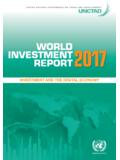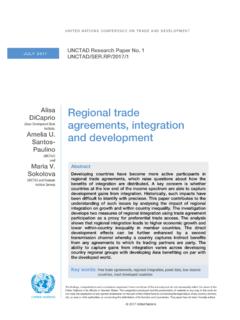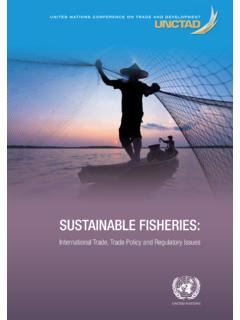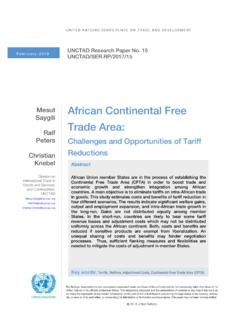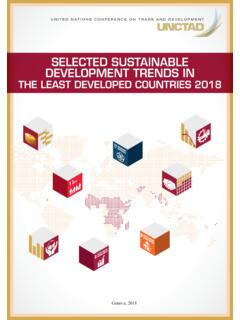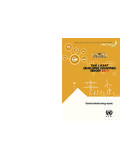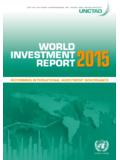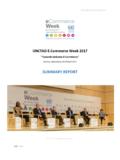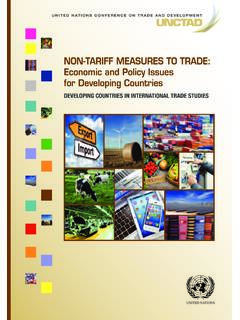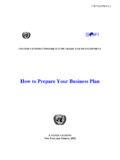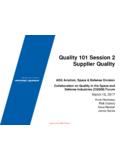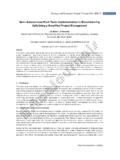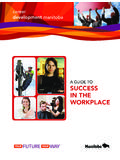Transcription of Dr. Duong Van Hop - UNCTAD | Home
1 Dr. Duong Van Hop A CASE STUDY ON Collaboration project on taxonomic and ecological studies of microbes in Vietnam and utilization under NP on ABS BETWEEN Institute of Microbiology& Biotechnology (IMBT) Vietnam National University, Hanoi (VNU) AND Japan National Institute of Technology and Evaluation (NITE) Vietnam National University, Hanoi (VNU) Institute of Microbiology and Biotechnology (IMBT) = Objectives = 1)Conservation of biological diversity, 2)Sustainable use of its components, and 3)Fair and equitable sharing of the benefits arising out of the utilization of genetic resources. Convention on Biological Diversity: CBD Bonn guidelines on ABS The Nagoya Protocol was adopted at 1:29 30 October 2010. NAGOYA PROTOCOL ON ACCESS TO GENETIC RESOURCES AND THE FAIR AND EQUITABLE SHARING OF BENEFITS ARISING FROM THEIR UTILIZATION TO THE CONVENTION ON BIOLOGICAL DIVERSITY Microbial world (1) Almost microbes are invisible need various techniques in studying them (2) Much Difficul in managing microbial GR in comparing to animal and plant (3) Amount 1-5% microbes are reported from the world so there is no traditional knowlege to many microbes.
2 Microbial cullures is starting GR for biotechnology and bioindustry (good values in medicine , pharmacy, comestic, food products) 1. Isolation 3. Genetical improvement 4. Pilot fermentation 5. Production fermentation 6. Product development and comercialization National Bioresources Centers (NBRCs) Universities and Institutions Factories & Companies Asean Consortium for the conservation and sustainable use Microbial resources (ACM). Members (ACM) are 23 Organizations from 13 Countries - 11 Culture Collections Included - -LIPI -MARDI -Univ. Philippines -Univ. -NITE -RIKEN-BRC -Institute of Microbiology Chinese Academy of Sciences -KRIBB-BRC -NAAS -KNRRC -Institute of Biology Mongolian Academy of Sciences -Vietnam National Univ. -Ministry of Environment BIOTEC -Research Institute of Science -Pathein Univ.
3 -IMTECH. ACM established in 2004, at Kisarazu, Chiba, Japan Aim of the ACM Framework for international cooperation to encourage microbiological researches Construction of the mechanism for academia and industry to utilize microbial resources Establishment of Microbial Resource Centre network Establishment of international standards for biological material transfer and benefit-sharing Improvement and share of standardized techniques Task Forces in ACM 1. Asian BRC Network (ABRCN) Chair: Ken-ichiro Suzuki (Japan) 2. Human Resource Development (HRD) Chair: Rosario G. Monsalud (Philippines) 3. Management of Material Transfer (MMT) Chair: Katsuhiko Ando (Japan) The ACM members expect the expansion of the activities to reach the international standardized scheme to encourage microbiologists to study biological diversity to solve the global problems on environments and human welfare.
4 Case study of IMBT, VNU - DOB, NITE, Japan on collaboration project on taxonomic and ecological studies of microbes in Vietnam and utilization under NP ABS Mutual interest VTCC,IMBT, VNU-Vietnam Establishing Vietnam Culture Collection and strengthening capacity in studying microbial diversity and management DOB,NITE, Japan Enrichment culture collection and studying tropical microbial diversity in Vietnam The project divided by 2 phase: Phase 1: From 2004- 2015 focussing on studying microbial diversity in Vietnam and culture collection management. Phase 2: from 2016 -2021 for utilization of the microbial GR Signing of Memorandum of Understanding (MOU) between the Ministry of Science and Technology (MOST) of Viet Nam and the National Institute of Technology and Evaluation of Japan for the Joint Research Program on Conservation and Sustainable Use of Biological Resources Signing for MOU between Dr.
5 Le Minh Sat, Vice Director General of Department of Science and Technology, MOST, and Mr. Masahiro Miyazaki, Director General of Department of Biotechnology, NITE, on 15 March 2004, Kisarazu, Chiba, Japan Main outcomes from phase 1 Technology tranfering Enrichment of Vietnam Type Cultures Collection (VTCC) Providing qualified data for VTCC Building up E-catalogue of VTCC Finding new taxa of microbe in Vietnam Manpower development Publication in domestic & Internatinal Journals Tokyo. 23 Working together=Technology transfer Amylase CMCase Xylanase Protease Phytase Dioxygenase Screeing enzyme producers Antibiotic Screening from Actinomycetes T. Suemoto and S. Miyadoh (NITE/NBRC) Collect soil samples as sources for actinomycete isolation. Transfer the soils to glass Petri dishes, and put them, opening the lids, at room temperature or higher for 5-7days.
6 This process promotes actinomycete spore formation and decreases bacterial cell number. Heat at 100 C for 30min. (Close the lids of Petri dishes) Non-spore forming bacteria are killed. Most actinomycete spores do not die in these conditions. Sprinkle (or spread) the treated soil samples on HV-agar*1, directly. Pick up actinomycete colonies by toothpick and transfer them to new HV-agar. 4 strains / Petri dish Transfer the isolates from HV-agar to YS-agar*2 in order to purify the colonies. 1 strain / Petri dish Drying 30 C, 5days Incubation 28 C, 7days Incubation 28 C, 6days 2nd Screening to select the strain producing antibiotics in liquid medium 1st Screening to select the strains producing antibiotics 3rd Screening to select the strain producing organic solvent-soluble antibiotics*4 Isolation of Actinomycetes Cultivate the selected strains in over 400 ml of liquid medium.
7 Extraction, Purification and Identification of Antibiotics 1st day 6th day 13rd day 19th day 41st day 44th 59th day 60th day 61st day Concentration Analyze the active fraction by LC/MS (retention time, molecular weight and UV absorption). Elucidate the structure by LC/MS data, biological activity and producing strain based on database. 22nd day Incubation 28 C, 3days Transfer purified and selected isolates to slant culture (YS-medium). Remove duplicate strains by morphological observation. Spreading the treated samples Pick up colonies Purification of the isolates Preservation of the isolates *1 Selective isolation medium for actinomycetes. HV stands for Humic acids-Vitamin . Actinomycetes play a role as decomposers of humic acids, difficult-to-degrade organic matters.
8 LC/MS analysis Database search Identification of antibiotics Large scale production Sampling of soils Drying of soil samples Heating of the samples Incubation 30 C, 100rpm 3days Packed column chromatography Extract with organic solvent (ethyl acetate) and purify the antibiotic by using some chromatographic (silica-gel column, gel-filtration, TLC, LC etc.) methods. Bioassay for antibiotic activity by paper disk method) Anthracyclines antitumor Ethyl acetate extraction *2 YS-agar medium is often used for purification and subculture. YS stands for Yeast extract and Starch . Because of its nutrient richness, it is suitable for the growth of many kinds of bacteria. *3 The agar medium in which test organisms have inoculated. Four kinds of organisms used in this case: Gram positive bacteria (Bacillus subtilis & Kocuria rhizophila), Gram negative bacteria (Escherichia coli), yeast (Candida albicans) Extraction and purification of antibiotics Inoculate the selected actinomycetes (1 strain / Petri dish) on antibiotic-producing agar medium (soybean meal agar).
9 Inoculate the strains identified as antibiotic producers in the 1st screening into the antibiotic-producing liquid medium (80ml). Mix ethyl acetate with same volume of any culture filtrate which passed at the 2nd screening, and then centrifuge for separation into solvent layer and water layer. Incubation 30 C, 100rpm 3days 22nd day Incubation 30 C, 13days 36th day 36th day 39th day 40th day 40th day 41st day Hollow 4 pieces out of the agar medium with a straw, and put one of them on each bioassay plate*3. On the next day, if a growth-inhibition zone is formed around the agar piece, the actinomycete produces antibiotics against assay organisms. Put the paper disks dipped in the culture filtrates on bioassay plates*3. On the next day, if a growth-inhibition zone is formed around the paper disk, the strain can produce antibiotics in the liquid medium.
10 Put paper disks dipped in the solvent layer on bioassay plates*3. On the next day, if a growth-inhibition zone is formed, the strain is considered to produce organic solvent-soluble antibiotics. Bioassay for antibiotic activity (agar-piece method) Antibiotic production on agar medium Production in liquid medium Bioassay for activity of solvent layer Antibiotic extraction with organic solvent Bioassay for antibiotic activity (paper disk method) 35th day OHOOR1 OOOR2 OHOHNH2H3 COH*4 Organic solvent-soluble antibiotics were targeted in this case, because of experimental easiness, concentration of solvent. Laboratory 1 Laboratory 2 Advance Manpower development 16 visits (Scientists and researchers) from VTCC to NITE (1-2 months ): 10 visits of scientists to attended annual ACM meeting ( , III,IV,V,VI, ,IX) Conducting 18 Technical training workshops at IMBT for a number of 150 Vietnam participants Annual project workshops (2004-2015) Visits of VTCC young microbiologists training at NITE, japan Exchange of Researchers Ms.
